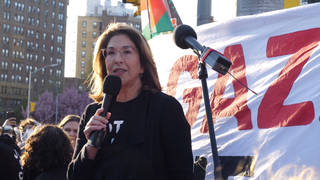
Related
Several hundred protesters arrived at the home of Karl Rove, Bush’s top political adviser, on Sunday afternoon to call for educational opportunities for immigrants. We speak with an activist who led the protest and who spoke with Rove after he agreed to meet with two members of the demonstration. [Includes rush transcript]
One week after hundreds of thousands of demonstrators took to the streets to protest the first anniversary of the Iraq invasion, several hundred people protested in Washington DC this weekend to call for educational opportunities for immigrants.
The protesters took the streets on Sunday afternoon. But they didn’t march down Pennsylvania Avenue or the Mall, instead–they went to Karl Rove’s house.
Rove is President Bush’s top political adviser and is best known as the driving force behind Bush’s taking of the presidency.
Several hundred protesters arrived at Rove’s house in school buses on Sunday afternoon calling for Bush to advocate the Development, Relief and Education for Alien Minors Act, known as DREAM. The bill would permit immigrants who have lived in the United States for at least five years to apply for legal resident status once they graduate from high school.
- Emira Palacios, is Co-Chairperson of National People’s Action, a 33-year-old multi-racial, ethnic, inter-generational non-partisan coalition of hundreds of local community organizations. She led the protest this weekend at the home of Karl Rove, President Bush’s Senior Policy Advisor.
Transcript
AMY GOODMAN: We’re joined now by Emira Palacios, a 33-year-old multiracial ethnic coalition leader. She led the protest at Karl Rove’s house and spoke to him. Welcome to Democracy Now!
EMIRA PALACIOS: Thank you for inviting me here.
AMY GOODMAN: It’s good to have you with us. Can you tell us what happened at Karl Rove’s house?
EMIRA PALACIOS: Well, of course, I want to first say that we had invited Karl Rove or a representative to come to our workshop that morning on immigrant rights. We made several attempts. We sent letters. We talked to his secretary. We clearly said — they said he wasn’t available. We decided to go to his house, and talk to him. Of course, you know, he first opened the door and yelled get out of my property, and then slammed the door and went back in, and I guess he called the police. So, during this time, we just kinda sang and kept asking to see them and chanted and Secret Service arrived and they asked us to — we asked all we want is a meeting and then we’ll leave. So, he said, okay. He agreed to meet with us — two of the co-chairs, you know, we have three co-chairs. We are the ones who were going to meet with him, so if you ask everybody to get on the buses and we’ll — and so, we did that and so we went. He opened his garage door and we entered the garage and then he closed the door behind us. There was a police officer that we talked to. So, he used — well, he used — on our faces. He told us how that we come to his house and we had disturbed his two children, a 10-year-old and 14-year-old. They said they were crying. I told him I wasn’t — it was not our intention to make them cry, but you know, we have 65,000 students that graduate from high school that wake up every morning with the reality that they can’t go to college. That’s disturbing to us. So, we try in a civilized way of — we played by the rules, and we couldn’t get you to come to the workshop so we could give you the message, so we had to come you to. Our organizations tried their own ways. We spent money through the years to come to the capitol to talk to the people who can impact — who can help us fix our problems. They don’t come. So, we couldn’t — we could not leave Washington, D.C., without giving him the message that we went there to give.
AMY GOODMAN: We’re talking to Emira Palacios, one of the protesters who wept to Karl Rove’s home this weekend. Why did you target Karl Rove? How exactly is he related to the D.R.E.A.M. legislation?
EMIRA PALACIOS: The D.R.E.A.M. act has existed through cosponsors. If it’s brought down to the floor, it will pass. We feel that Karl Rove, you know has a huge — you know, has a part to advise the President to come publicly and support D.R.E.A.M. act, and call Senator Frist, the minority Senate leader, and ask him to bring it to the floor for a full senate vote.
AMY GOODMAN: What do you hope to accomplish at this point? Where did you take this protest now?
EMIRA PALACIOS: Well, as — we come to our own states. We have 39 different states represented, and we just come locally and try to work on a local level, you know, bringing our message. Here in Kansas, we are trying to get the in-state tuition passed. We will allow the students who reside on campus to pay in-state tuition instead of out of state tuition. Each of us goes back home and try to work on continuing to support the — support this effort. We hold telephone conferences and we cannot decide what’s the next strategy. A lot of us–the next day, yesterday, we held briefs on the senate and the house side. Also addressing, you know, the members of congress to support not only this, but other issues. We will — we brought the people’s platform briefing, which was nine issues which that we were working at NPA currently.
AMY GOODMAN: I want to thank you for being with us. Co-chair of the National People’s Action, took the protest to Karl Rove’s home this weekend in Washington, D.C.












Media Options